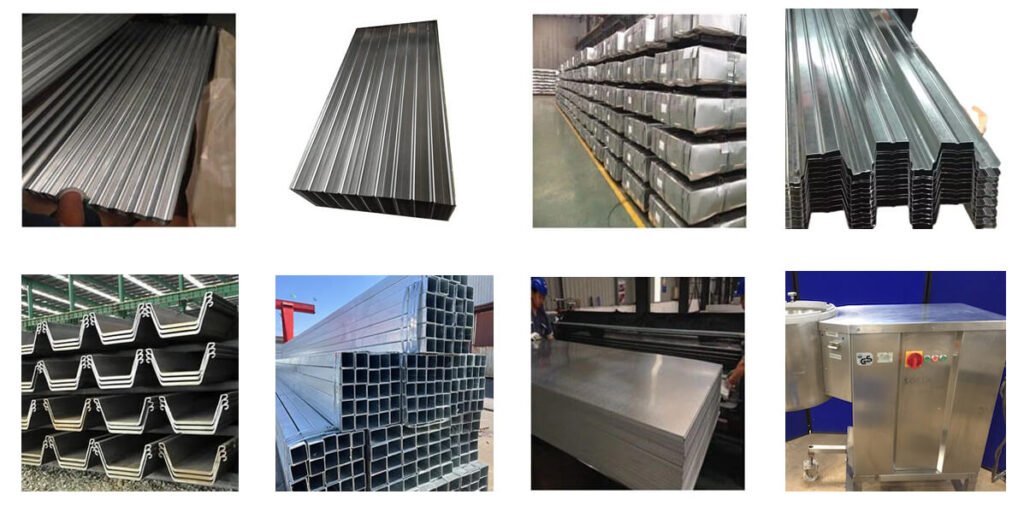G350 Steel Grades
High-Strength Galvanized Steel for Structural and Industrial Applications
G350 Steel Technical Specifications & Applications
G350 Steel is a high-strength structural steel with a minimum yield strength of 350 MPa, widely used in construction, engineering machinery, vehicle manufacturing, container production, and other applications that demand both strength and toughness. This steel grade offers excellent weldability and formability, performing reliably in cold bending, cutting, and stamping processes, making it suitable for manufacturing various structural and load-bearing components.
As a flagship product of Hengze Steel Group, G350 steel delivers consistent quality and strict compliance with standards, meeting the high-performance demands of galvanized structural steel customers worldwide.
Table of Contents
1. Typical Uses & Selection Guidance
- Structural Applications – G350 steel offers a balanced combination of moderate yield strength (350 MPa) and excellent ductility, making it ideal for cold-formed structural sections such as purlins, channels, and framing components.
- Corrosion Protection – When hot-dip galvanized or metallic-coated (Zinc, Zinc-Aluminium), G350 delivers reliable corrosion resistance for roofing, wall cladding, gutters, and general building applications in mild to moderate environments.
- Forming Advantages – Lower yield strength compared to G450 allows easier bending, tighter radii, and reduced risk of cracking—ideal for complex profiles and precision fabrication.
2. Technical Specifications Table
1. Chemical Composition Requirements (Max %)
| Steel Grade | Carbon (C) | Manganese (Mn) | Phosphorus (P) | Sulfur (S) |
|---|---|---|---|---|
| G350 | 0.20 | 1.20 | 0.04 | 0.03 |
2. Mechanical Property Requirements
| Steel Grade | Min. Yield Strength (MPa) | Min. Tensile Strength (MPa) | Min. Elongation (%) Lo=50mm | Min. Elongation (%) Lo=80mm | Bend Angle (°) | Mandrel Diameter (× thickness t) |
|---|---|---|---|---|---|---|
| G350 | 350 | 430 | 20 | 18 | 90 | 4t |
3. Coating Adhesion Requirements (180° Bend Test)
| Coating Class | Mandrel Diameter (× thickness t) |
|---|---|
| Z, ZA, ZF, ZM (Z100, ZA90, ZF80, ZF100) | 0t |
| Z200, ZA135, ZA180, ZM90, ZM120, ZM150, ZM180 | 2t |
| Z275, ZA225, ZA275, ZM220, ZM275 | 2t |
| Z350, ZA350, ZM350 | 2t |
| Z450, ZA450, ZM450 | 3t |
| Z600 | 2t |
4. Hot-Dip Metallic Coating Types Applicable for G450 Steel
| Steel Grade | Applicable Coating Types |
|---|---|
| G350 | Z (Zinc), ZA (Zinc-Aluminium), ZF (Zinc-Iron Alloy), ZM (Zinc-Magnesium Alloy), AZ (Aluminium-Zinc), AM (Aluminium-Magnesium Alloy) |
3. G350 vs G450 — what’s the difference?
- G350: Structural steel with a minimum yield strength of 350 MPa, offering higher ductility and excellent formability. Ideal for applications requiring complex bending, tight radii, and easier fabrication. Commonly used for roofing, wall cladding, gutters, and light structural components.
- G450: Structural steel with a higher minimum yield strength of 450 MPa, providing greater load-carrying capacity and stiffness. Suitable for lighter yet stronger sections, such as cold-formed purlins and framing, where strength-to-weight ratio is critical.
G350 Steel FAQ:
Minimum yield strength: 350 MPa
Minimum tensile strength: 420 MPa
Elongation: 14–15% depending on specimen length
Bending performance: 180° bend with a minimum bend diameter twice the sheet thickness
The metallic coating must withstand specified bend diameters (typically 1–2 times the sheet thickness) without cracking or peeling, ensuring excellent adhesion and durability of the coating.
G350 steel is commonly used in construction roofing, wall cladding, light structural components, and various general industrial applications, favored for its robust mechanical strength and corrosion resistance.
Compared to AS/NZS 3678 Grade 350 structural steel, G350 steel has slightly lower strength but excellent formability. AS/NZS 3678 steel covers a broader thickness range and is suitable for heavier structural applications.







